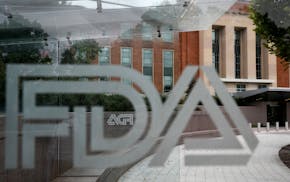Mother's Day is the Super Bowl of the floral industry.
Americans are expected to spend $2.4 billion on flowers this year, accounting for about a quarter of the industry's annual sales and nudging out Valentine's Day as the biggest blooming holiday, according to the National Retail Federation (NRF).
At Artistic Floral in Edina late last week, the orders came in fast and furious: tulips, snapdragons, lilies, orchids.
"The real gardeny stuff," said owner Shawn Davis, who makes about 16 percent of total sales around Mother's Day.
While it may feel like a Hallmark holiday, the event that always falls on the second Sunday in May gained widespread acceptance in 1914, when a proclamation from President Woodrow Wilson called on Americans to give mothers a public expression of reverence.
The tradition was first championed in 1908 by Anna Jarvis, a Civil War-era peacenik and social activist from West Virginia who later was said to be disgusted by the commercialization of the day.
It continues to be a challenge. This year, U.S. consumers are expected to spend an average of $172.22 on Mother's Day, down slightly from last year's record-high $172.63, according to the National Retail Federation's annual survey.
They will splurge on jewelry, electronics and brunch. But flowers will be part of the package for two-thirds of those who plan to do something nice for dear old Mom, according to the NRF.
Flowers' enduring allure was in full bloom at the height of the frenzy at Artistic Floral, where Davis juggled to keep a steady stream of deliveries, drivers and floral designers in motion. He's been in business since 1988, finding a way to ride through three economic downturns in an industry built on consumers' discretionary income.
In 2007, there were nine flower shops in Edina. Just two survived the Great Recession.
Another, more lasting threat to small independents nationwide has come from online sites such as 1-800-Flowers.com and FTD.com, along with grocers and national retail chains that can afford to sell flowers as a loss leader. Online discounters and grocers now control 55 percent of the cut-flower market, according to the research firm IBISWorld, and the outlook is far from rosy for small storefronts.
The sites are popular with consumers who order preset arrangements online, but mom-and-pop shops like Davis' make the slimmest of margins when working with the site, even as they risk their reputations if something goes awry with the delivery or arrangement.
The online companies take a 20 to 30 percent cut plus a service charge from customers, Davis said, while Artistic Floral designers are locked into using a "recipe," as if they are making cookies.
"Three pink carnations, one white daisy," he said. "Unfortunately, 90 percent of people order that junk."
Davis currently subscribes to all five of the flower wire services, but says he's so frustrated with the process that he will "clean house" after Mother's Day and drop all but two. It's a leap of faith on the belief that loyal customers will be willing to pay for the creativity and level of service Artistic Floral offers.
"I'll have to take a chance," Davis said. "We won't be as busy, but we won't be spinning our wheels, we won't be running people ragged."
Jackie Crosby • 612-673-7335

Senate passes bill forcing TikTok's parent company to sell or face ban, sends to Biden for signature
USPS commits to rerouting Reno-area mail despite bipartisan pushback and mail ballot concerns
